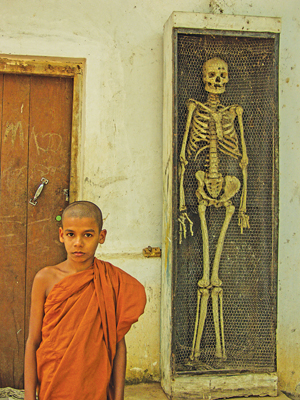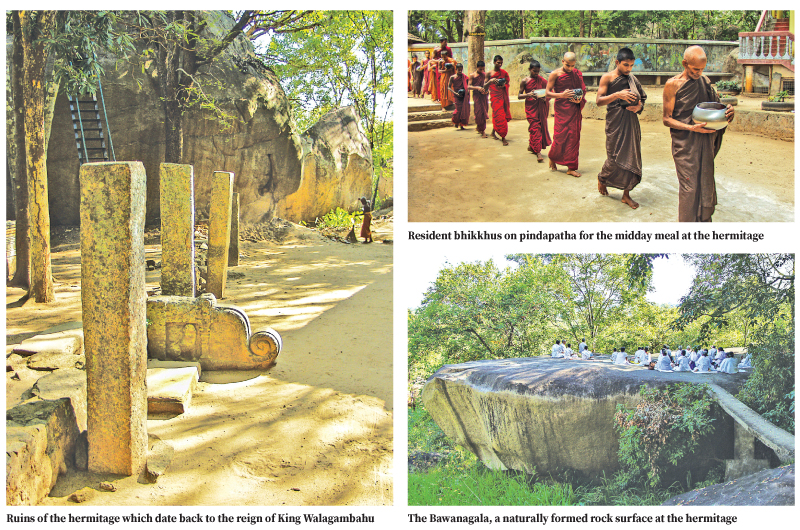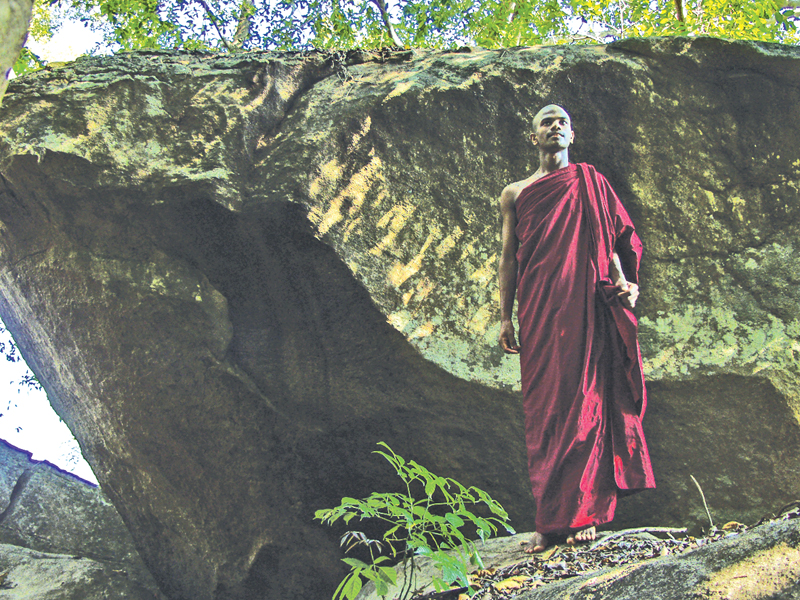It had been our cherished dream to visit the Mahiyanganaya temple and Dambana, the ancestral Adivasi village. We had spent years looking forward to it, and finally, it took months to plan the trip. Mahiyanganaya was not a disappointment, but there was something different for us in the trip as well.
Long before we reached Dambana, we had made up our minds on what we wanted to do there – to document the daily life of the fast-vanishing indigenous people of our land. However, as we drove along the A-26 Mahiyanganaya-Padiyatalawa road on one sunny morning, we were struck with the idea of visiting the ancient forest hermitage called Mawaragala, which lies on the slope of a rocky mountain in Dambana. We reached the Mawaragala forest hermitage which is 15 kilometres away from Mahiyanganaya before visiting the ancestral Adivasi village, Kotabakiniya.
A neatly kept pathway led us on a steady climb through the forest and rock boulders, the greenery all around providing a salubrious climate. It was a hot sunny morning, yet the ample tree shade protected us from the heat. The rocky landscape and the serene undisturbed environment seemed ideal for meditation. Those pathways were leading to kutis or bhikkhus’ abodes built in drip-ledge caves, where bhikkhus dwell and meditate.
The Mawaragala hermitage is on top of a rocky mountain in a 500-acre forest. The drip-ledge caves with Brahmi inscriptions had been built on the slope of the mountain. The chief bhikkhu of the hermitage has taken steps to protect the flora, while growing more trees in the surrounding area of the hermitage.
Arahat Maliyadeva and other bhikkhus

A novice bhikkhu in front of the skeleton that bhikkhus use as an
object to meditate on at the hermitage
At the monastery, we met a young resident novice Samanera bhikkhu named Ven. Kewle Samithawansa Thera. He took us to every nook and corner of the hermitage while explaining the history of the site to us. First, he took us to the chief bhikkhu’s spacious kuti. The chief bhikkhu said the hermitage’s history goes back to King Valagambahu’s reign. He said that according to legend, an erudite bhikkhu called Ven. Arahat Maliyadeva Thera and 60 other bhikkhus lived at the place during the time. Later, those rock caves had been used by the Adivasi people of Dambana for dwelling.
There are enough kutis for at least 25 bhikkhus at the hermitage. These have been built in the drip-ledge caves in the forest reserve, away from the entrance to the hermitage, where the shrine room is located in a cave. We saw a number of novice (samanera) bhikkhus in the hermitage. The children from Adivasi families have been ordained as novice bhikkhus. They go on Pindapatha to gather food every day.
A resting hall and an alms hall have been built for the devotees to prepare alms for the bhikkhus. It is only between 11.30 am and 1 pm that visitors are permitted to go to the areas where the kutis are located. We witnessed the midday dana (almsgiving) during our stay at the hermitage. Over 20 bhikkhus were present.
At 10 am, one novice Samanera bhikkhu sounds the hollow, wooden gong struck to signal the bhikkhus in distant kutis, informing them to gather near the main entrance. From there, they walk to the danasalawa (alms hall). It was a rare sight, to see them walking silently down the pathway on pindapatha, in keeping with the tradition dating back to the days of the Buddha.
They came in a single file, one after the other, each carrying an alms bowl. Once their feet were washed, they moved one by one and patiently let the devotees serve the alms, which they prepared in the morning, into their begging bowls. Then they retired into the alms hall a little further in the forest and sat down to partake of the food they had been offered.
A devotee is selected for each day of the year to offer alms. The chief devotee together with relatives and friends offers alms to the bhikkhus on the day assigned to him. Some would come to the hermitage the previous evening and stay overnight at the Giman Hala (resting hall) to prepare the morning and midday dana which will be offered the following day. Most devotees are from nearby places, while some are from faraway places such as Polonnaruwa, Kandy and Ampara.
Pirivena for novice bhikkhus
While there are local mediating bhikkhus as permanent residents at the monastery, foreign bhikkhus also stay for a short period to practise meditation. The monastery has also a pirivena (school for novice bhikkhus) for those who come from places such as Padiyathalawa, Maha Oya, and other remote areas. About 25 young novice bhikkhus study at the pirivena.
The Bawanagala is the most interesting place at the hermitage. The rock surface is a naturally laid floor area of about 25 square feet. Legend has it that it was where Arahat Maliyadeva and the 60 other bhikkhus meditated. The holes on the rock surface, it was learned, were indications that in the past, it was covered with a roof to offer shelter to the bhikkhus from the sun and rain.
The award-winning film ‘Suriya Arana’ was shot at this hermitage where a cluster of rocky boulders lies contrasting with the green canopy. Ven. Kewle Samithawansa Thera took us to the cave where the film was shot. A cluster of the massive caves lies on the mountain, and it is a little difficult to climb to the spot due to the steep slope of the mountain. It is a visual treat to anyone who loves nature.
As we walked under the towering trees and the dimly lit foliage, we spotted a variety of birds and a large number of endemic Toque macaques and Purple faced Leafy monkeys prospecting for food. They seemed to be increasingly confident in approaching people who usually give them food at the hermitage.
The Mawaragala hermitage is a gift of nature where silence and serenity prevail – an ideal place for meditating bhikkhus who aim to seek emancipation from the vicissitude of worldly life and finally attain Nibbana. The chief bhikkhu of the hermitage said the place is open to nature lovers – the best medicine for a stressed mind.










